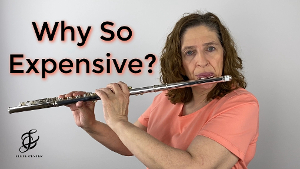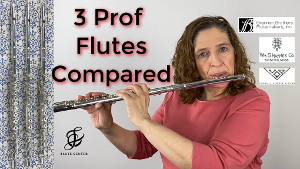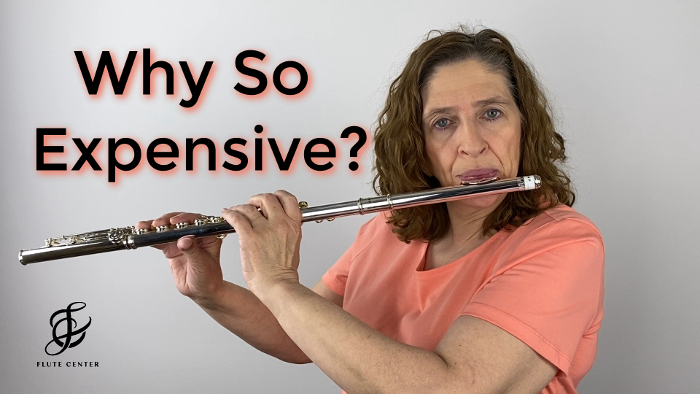Let me begin by assuring you that professional model flutes are well worth the money that you pay for them! Professional flutes are an absolute joy to play on. They are so much better than even the best intermediate flutes, even if that intermediate has a handcut headjoint on a step-up body.
There is no comparison!
Professional flutes enable the flutist to tongue sharply, to legato and taper, to easily get your high notes out, and to get a rich sound in the low register. The professional flute body has keys that enable your fingers to fly with a light and graceful touch unequalled in the lower models. The professional hand cut headjoint offers a variety of lip plate metals and embouchure hole cuts and shapes that enable a flutist to produce a beautiful variety of colors. This would be virtually unattainable on an intermediate level flute.
This is why professional flutists perform on professional model flutes. They are not only gorgeous to look at, but they also feel great in your hands, and enable you to give your very best performance.
That said, why are professional model flutes so expensive? And is there anything that you can do to drive down the cost? Well, some professional flute extras are optional. Other features are just part of the package – the cost of a professional model flute.
Here’s the rundown. We will look at eight categories: metal, maker, mechanism, headjoints, tubing, pads, extras, and maintenance. I will point out if and where you can compromise, and what that will cost you in dollars and performance value.
Metals
One of the top reasons that professional flutes are so expensive is the metals used to make them: silver, gold, and platinum. These metals cost more than the nickel alloys used in beginner flutes, and there is much more precious metal contained in professional flutes than in silver-plated intermediate flutes. So, more precious metal means more cost.
Than why do we use silver, gold, and platinum? Because it sounds so good! The beautiful look is just a side benefit. The sound quality that we can attain is the attraction to precious metals.
There are so many options too. You can have an all gold 14K flute from crown to B foot, including headjoint, lip plate, riser, body, tone holes, rings, ribs, and posts. You can even have gold springs. Not to mention platinum, or platinum plated. You could also have a gold headjoint, or just a gold lip plate, riser, etc. Some flute makers offer a blend of 5% gold and 95% silver. Or a 14K gold body with sterling silver keys; or 14K rings and tone holes; or 14K rose gold or white gold! Or 19.5K Gold!
The options seem endless!
In my opinion, once you move up to the precious metals, one is not better than the other. At that point it is just a matter of your preference. Which sound do you like best when you perform?
So, where can you compromise if cost is the issue?
No platinum, no gold. Just silver. Even move down from Sterling (.925) to Coin Silver (.900).
Personally, I own a professional model Haynes flute that is Sterling silver with a gold riser. The riser is the piece of metal that attaches the lip plate to the headjoint tube. I love what that little piece of gold does to my sound. It Is just enough for me. Although, sometimes when I try out flutes with more gold, my heart may wander toward that golden glow.
To find out more about how precious metals effect your performance, read my full blog on just this topic:
Which is Better a Silver Flute or a Gold Flute?
Maker
The best expression to use here is “this is where the rubber meets the road.” Beginner flutes are made in a factory. Professional model flutes are created in a workshop. Picture Santa’s Workshop at the North Pole. But instead of elves making toys, think of a master craftsman at a workbench surrounded by a 21st century array of magical tools and devices, toiling away day and night to create these flawless musical instruments that we simply call professional flutes.
Professional model flutes are called “handmade” or “hand crafted” because they are made by hand. They are handmade, hand rolled, and hand assembled. This personal touch is literally worth every penny. It is also what enables the flutist to make such breathtaking music. Professional flutes are the top of the craft, the state-of-the-art.
I am nearly breathless at the thought. But alas, this is the perfection that we crave. This artistry has a price. But we are so grateful that these bright young men and women dedicate their lives to perfecting their craft to create these musical masterpieces for us to perform on.
There is no compromise in this section. Your only option it to shop around because some professional models cost less than others. Just remember that you do truly “get what you pay for.”
Mechanism
The mechanism is the part of the flute that moves to the touch of your fingers. It includes the keys and everything that goes into making the keys open and close when your fingers press down and lift up.
The mechanism on a professional model flute is far and away so much better than an intermediate flute that you just must experience it for yourself. The very first time a professional flute is placed in your hands you can feel the difference in your fingers as you play through some scales. You can feel the light touch needed to push down those keys, and how responsive they are to your fingers.
Precision is the keyword to describe the mechanism in a professional model flute. This precision shines when you do your technical work, and your fingers fly across the keys. There is no comparison to an intermediate flute.
The price compromises that you can make in the mechanism are in the metals, inline vs. offset G, and the engraving.
All silver would be the least expensive. On some models you can add 14K gold rings for an additional $3,000. Others have gold alloy springs rather than stainless steel springs. This price difference would be nominal. So, I would not bother trying to make this change.
All flutes used to be made with an inline G. This just means that when you look down your flute, all the keys are in a straight line. Today, makers have moved the G key out of this line which allows your hand to not be bent so severely. This is an effort to prevent long-term hand injuries. But it sometimes comes at the cost of an increased price. You will find listings with offset G, or half-offset G costing $500+ more than inline G.
This may be worth the extra cost for you if you already have hand injuries or have larger hands. For me, I have always played the flute with an inline G. I have not developed any hand problems, and so I do not plan on changing to an offset G.
Additionally, some makers will add key engraving for an additional $1,000, $2,000 or even $3,000. So, if you see “key engraving” understand that those beautiful keys come at a premium.
To read more about how the flute mechanism effects your performance, read my blogs on this topic:
Comparing Soldered Tone Holes with Drawn Tone Holes
What Do Gold Springs Do for Your Flute?
Headjoints
Professional headjoints are referred to as handcut, hand rolled, or simply handmade. The flute makers want you to know that a master craftsman made the headjoint by hand: the lip plate and embouchure hole were cut by hand, the tubing was rolled by hand. And then all of these components were assembled by hand.
You can compromise on the price in two ways on a headjoint. The first is to compare all your options for the cut. Some cuts cost $500+ more than others. Check your options.
The second way is to check the metals that the headjoint is made from: silver, gold, and platinum. The more precious the metal, the greater the cost. Your options include the entire headjoint, just the lip plate, crown, and/or riser in many combinations. For example, platinum plated sterling silver!
Silver flutes come standard with silver headjoints. But from some makers, you can have a lip plate and/or riser made of 14K gold, 18K gold, or platinum for an additional $500, $1000, or $1500.
Of course, these prices are estimates and fluctuate with the price of the metals.
Additionally, you can add gorgeous etching to the lip plate. While it may not improve your tone, it may improve your look. That is what I would call a “pretty penny.”
To read more about headjoints, read my blogs and watch my videos about headjoints:
Does the Cut of Your Lip Plate Make a Difference on a Professional Flute?
Should You Put a Professional Headjoint on an Intermediate Body?
The Difference Gold Makes on a Headjoint – FCNY Sponsored
Tubing
The flute tubing is a term used to describe the cylinders that make the headjoint, body, and foot joint. As described above in the metals section, the tubing can be made of silver, gold, or platinum.
The tubing can also be made of varying thicknesses, which also differs between metals. Here’s the breakdown.
Silver:
Thin wall – 0.014 inches / 0.35 mm
Standard wall – 0.016 inches / 0.40 mm
Heavy wall – 0.018 inches / 0.45 mm
Gold & Platinum
Thin wall – 0.011 inches / 0.28 mm or 0.010 inches / 0.25 mm
Standard wall – 0.012 inches / 0.30 mm
Heavy wall – 0.014 inches / 0.35 mm
The thicker the wall, the more precious metal is used, which increases the cost, and the weight of the instrument. Thicker walls also increase the resistance when you play.
Although heavy wall gold tubing could cost an additional $2,500, tubing thickness should not be used as a cost compromise. It is to be selected by the flutist to match their own personal preferences and/or performance needs.
To find out more about how flute tubing effects your performance, read my full blog on just this topic:
Does Flute Tubing Thickness Matter?
Pads
The pads on a flute are the little lifesaver shaped pieces of fabric that are attached somewhere under the keys, such that when you press the key there is a seal made that perfectly prevents any air from leaking out. When you are trying to play a Low C, and one of your pads is leaking, it is impossible to the the Low C to come out – so frustrating! Professional model flutes have higher quality pads, that not only seal better, but they also release the keys faster, so you don’t glitch or crack between notes. These pads also last longer. That is, they are more durable and can handle the extra hours of practice that professional flutists need to prepare for performances.
Different manufacturers use different pads for their professional flutes. So, don’t be thrown off by names such as: Straubinger pads, Pisoni pads, Muramatsu pads, Sankyo pads.
These excellent pads are part of what makes a professional flute so good. So, there is no compromise in this section.
Extras
There are some things on a professional model flute that you can choose, let’s call them optional extras. Choosing these extras will make the flute more expensive and heavier. There are other things that you cannot choose. They are just part of what makes a professional flute, professional, and therefore make it more expensive, like the master craftsmanship, the mechanism, and the pads.
Here are some of the professional flute extras and what they may cost as an add-on in silver, gold or platinum:
Split E Mechanism + $350 – 2,500; + $3,500 in platinum
C-sharp Trill + $750 – 2,400; + $3,300 in platinum
Offset G or Half-Offset G +100 – 500
D-sharp Roller + $250 – 600; + $1,200 in platinum
Half Closing Thumb + $800; + $3,000 in platinum
High E Facilitator + $200
Other extras include:
B foot joint with Gizmo key
Drawn or Soldered Tone Holes
Pointed or Y-key arms
The B foot joint is usually standard on a professional model flute. But some offer a C foot instead.
To find out what each of these extras may do for your performance, read my full blog on just this topic:
Professional Flute Extras – Do You Need Them?
So, if you’re really trying to move up to a professional model flute, and you must make it less expensive you can opt out of the extras at the time of purchase, depending on what is in stock. If you want to opt out of all the extras, you may need to special order that flute with no extras, and you may just have to wait several months for them to make you this custom flute. But if that’s what you must do to enter the professional market, then I say it is well worth it.
Maintenance
While maintenance strictly speaking will not make a professional model flute more expensive to purchase. If will however over time cost more to have a professional flute maintained. You are not going to send your professional model flute to your local high school band Director for a clean oil adjust (much less a complete overhaul). No offense to band directors, bless their hard-working souls. I started out my career as a band Director. And yes, I repaired many instruments in my time. But I would never have agreed to work on a professional model flute. NEVER!
You will need a professional technician to work on your professional model flute. But not to worry, when you buy your very first professional flute, ask where you should have it serviced. Most likely they will have an in-house team and strong relationships with others who can help you.
Conclusion:
The bottom line in my opinion is that if you can afford to buy a professional model flute, buy it! You will love it. But if you’re not serious about playing the flute, well, then spend your money on chocolate.
It is important to remember that when you are shopping for a professional model flute that you are not shopping for the price, or for the performance of the instrument. You are shopping to improve the performance of the flutist. You are selecting the best instrument for you as a flutist to further your career and your performance enjoyment!
You should be asking which headjoint and flute give you the best tone.
This metal or that metal?
This cut or that cut?
Do I want more resistance or less resistance?
Can I achieve more colors with this combination or that combination?
I know that I opened with the question “why are professional model flutes so expensive?” But if you are reading this because you are already shopping for one, the real question that you must answer is why? What are your goals as a performer? Once you figure out what you really want as a flutist, then you can find the flute that will best serve you to meet those goals. As I stated at the beginning, professional flutes are an absolute joy to play on, and are well worth their cost.
However, if you cannot afford a professional model flute, but you really want to step-up from your step-up flute, then consider getting a hand cut headjoint. That one upgrade can really make a difference in your tone production. But caveat emptor (let the buyer beware), re-read the above sections on the professional flute body, and be sure you are willing to leave without that handmade masterpiece.
Above all have fun playing your flute!
Doctor Flute
Why Are Professional Flutes So Expensive? Flute Center Sponsored

Comparing 3 Professional Flutes Haynes Powell Brannen – Flute Center Sponsored

Professional Flute Extras – Do You Need Them?

3 Levels of Haynes Flutes Compared Custom Handmade vs Q Series Semi-Pro vs Amadeus Intermediate

If you are serious about trialing a professional model flute, please contact my friends at the Flute Center, and use my code for some special perks: DRFLUTE
To start your flute trial, you’ll first want to go to flutecenter.com and fill out the form. Here’s the link:
https://flutecenter.com/pages/trial-form
Then put my code: “DrFlute” in the box labeled “Influencer Code.”
This code gives you these extras with some exceptions:
*3 extra days to try your flute – that’s a 10-day trial instead of only 7 days
*6 extra months of warranty on your new flute – that’s 18 months instead of only 12 months
*Free Shipping of up to three flutes, piccolos, and/or headjoints at a time for trial!
*10% off sheet music
*Free domestic shipping on instrument purchases
Plus, when you purchase a new flute using my code, Flute Center will pay me a small commission. Thank you!
